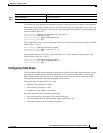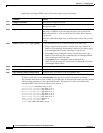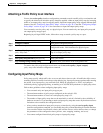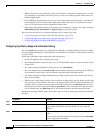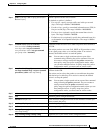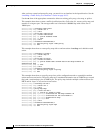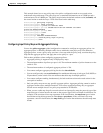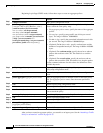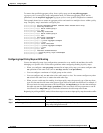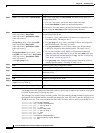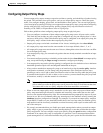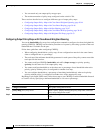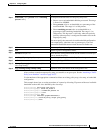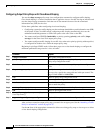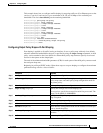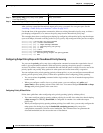
30-41
Cisco ME 3400 Ethernet Access Switch Software Configuration Guide
78-17058-01
Chapter 30 Configuring QoS
Configuring QoS
To remove the specified aggregate policer from a policy map, use the no police aggregate
aggregate-policer-name policy map configuration mode. To delete an aggregate policer and its
parameters, use the no policer aggregate aggregate-policer-name global configuration command.
This example shows how to create an aggregate policer and attach it to multiple classes within a policy
map. The policy map is attached to an ingress port.
Switch(config)# policer aggregate example 10900000 80000 exceed-action drop
Switch(config)# class-map testclass1
Switch(config-cmap)# match access-group 1
Switch(config-cmap)# exit
Switch(config)# class-map testclass2
Switch(config-cmap)# match access-group 2
Switch(config-cmap)# exit
Switch(config)# policy-map testexample
Switch(config-pmap)# class testclass
Switch(config-pmap-c)# police aggregate example
Switch(config-pmap-c)# exit
Switch(config-pmap)# class testclass2
Switch(config-pmap-c)# police aggregate example
Switch(config-pmap-c)# exit
Switch(config-pmap)# exit
Switch(config)# interface fastethernet0/1
Switch(config-if)# service-policy input testexample
Switch(config-if)# exit
Configuring Input Policy Maps with Marking
You use the set policy-map class configuration command to set or modify the attributes for traffic
belonging to a specific class. Follow these guidelines when configuring marking in policy maps:
• When you configure a set qos-group command in an input policy map, you cannot configure other
set operations in the same class (such as set dscp, set cos, or set precedence).
• You can configure a maximum of 16 QoS groups on the switch.
• You can configure only one set action with a table map in a class. You cannot configure any other
set action in the same class as a set action with table map.
• When you use a table map for marking in an input policy map, the protocol type of the map from
type of action must be the same as the protocol type of the associated classification. For example, if
the associated class map represents an IP classification, the map from type of action that references
the table map must be either dscp or precedence. If the associated class map represents a non-IP
classification, the map from type of action that references the table map must be cos.
Beginning in privileged EXEC mode, follow these steps to create an input policy map that marks traffic:
Command Purpose
Step 1
configure terminal Enter global configuration mode.
Step 2
policy-map policy-map-name Create a policy map by entering the policy map name, and enter
policy-map configuration mode.



